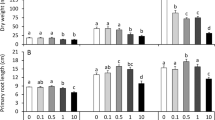Abstract
Herbicide residues may affect seedlings during early stages of their development. We studied this possibility by the use of light and electron microscopy after incubation of germinating seeds ofPisum sativum L. andZea mays L. with different concentrations of chlorsulfuron and metsulfuron-methyl. By in vitro experiments, we have shown that both herbicides caused growth reduction of the very young roots, and severe ultrastructural alterations and injuries of the root caps of both species. Chlorsulfuron caused increase of electron-dense material in the vacuoles, cytoplasmic degeneration even in the inner secretory cell layers of the cap, and disruption of the amyloplast envelopes with release of the statolithic starch grains. In the initial cell complex of the root cap, the herbicides caused the formation of large concentric aggregates of the rough ER and wall disformations in the cells adjacent to this complex. Scanning electron microscopic observations revealed a decrease of the slime layer ensheathing the root cap and the subapical root surface.
We conclude that even in early stages of seed germination, both herbicides seriously affect the gravity perception centre (consisting of the statocytes), and the secretory tissue of the root caps, thus probably disturbing the processes of gravitropism and the protective slime secretion of the roots.
Similar content being viewed by others
References
AndersonJ J and DulkaJ J 1985 Environmental fate of sulfometuron methyl in aerobic soils. J. Agric. Food Chem. 33, 596–602.
BacicA, MoodyS F and ClarceA E 1986 Structural analysis of secreted root slime from maize (Zea mays L.). Plant Physiol. 80, 771–777.
BarlowP W 1974 Recovery of geotropism after removal of the root cap ofZea mays. J. Exp. Bot. 25, 1137–1146.
BarlowP W and HinesE R 1982 Regeneration of the root cap ofZea mays L. andPisum sativum L.: a study with the scanning electron microscope. Ann. Bot. 49, 521–529.
BergfeldR and SchopferP 1984 Transitory development of rough endoplasmic reticulum aggregates during embryo maturation in seeds of mustard (Sinapis alba L.). Eur. J. Cell Biol. 34, 27–33.
CiamporovaM and MistrikI 1993 The ultrastructural response of root cells to stressful conditions. Environ. Exp. Bot. 33, 11–26.
ClowesF A L and WoolstonR E 1978 Sloughing of root cap cells. Ann. Bot. 42, 83–89.
DyerW E and FayP K 1984 The effect of chlorsulfuron soil residues on 11 crops, 36 month after herbicide application. West. Soc. Weed Sci. Res. Rep. Weed Science Society of America, Champaign, IL. 226p.
IversenT H and RommelhoffA 1978 The starch statolith hypothesis and the interaction of amyloplasts and endoplasmic reticulum in root geotropism. J. Exp. Bot. 29, 1319–1328.
KristenU 1977 Auffällige ER-Konfigurationen in Protein-Polysaccharidschleim-sezernierenden pflanzlichen Drüsen. Planta 133, 161–167.
LaneB P and EuropaD L 1965 Differential stayning of ultrathin sections of epon-embedded tissue for light microscopy. J. Histochem. Cytochem. 13, 579–582.
LarossaR A and SchlossJ V 1984 The sulfonylurea herbicide sulfometuron methyl is an extremely potent and selective inhibitor of acetolactat synthase inSalmonella typhimurium. J. Biol. Chem. 259, 8753–8757.
NichollsP H, EvansA A and WalkerA 1987 The behaviour of chlorsulfuron and metsulfuron in soils in relation to incidents of injury to sugar beet. Proc. British Crop. Prot. Conf. Weeds 2, 549–556.
NorthcoteD H and Pickett-HeapsJ D 1966 A function of the Golgi apparatus in polysaccharide synthesis and transport in root cap cells of wheat. Biochem. J. 98, 159–167.
PaullR E and JonesR L 1976 Studies on the secretion of maize root cap slime. IV. Evidence for the involvement of dictyosomes. Plant Physiol. 57, 249–256.
Piche Y AckerleyC A and PetersonR L 1985 Localization of L-fucose in the root cap and slime ofZea mays L. utilizing fluorescent lectin conjugates and colloidal gold-lectin techniques. Plant Sci. 40, 179–184.
RayT B 1982a The mode of action of chlorsulfuron: a new herbicide for cereals. Pestic. Biochem. Physiol. 17, 10–17.
RayT B 1982b The mode of action of chlorsulfuron: the lack of direct inhibition of plant DNA synthesis. Pestic. Biochem. Physiol. 18, 262–266.
RostT L 1984 The comparative cell cycle and metabolic effects of chemical treatments on root tip meristem. III. Chlorsulfuron. J. Plant Growth Regul. 3, 51–63.
RougierM 1981 Secretory activity of the root cap.In Encyclopedia of Plant Physiology. New Series 13B. Ed. FLoewus and WTanner. pp 542–574. Springer, Berlin, Heidelberg, New York.
ScheelD and CasidaJ E 1985 Sulfonylurea herbicides: growth inhibition in soybean cell suspension cultures and in bacteria correlated with block in biosynthesis of valine, leucine or isoleucine. Pestic. Biochem. Physiol. 23, 398–412.
SchröderH E, RossinskyU and MüllerW 1980 An established routine method for differential staining of epoxy-embedded tissue sections. Microsc. Acta 83, 111–116.
SmithA E 1986 Persistence of the herbicides [14C] chlorsulfuron and [14C] metsulfuron methyl in prairie soils under laboratory conditions. Bull. Environ. Contam. Toxicol. 37, 698–704.
SmithA E and AubinA J 1992 Degradation of the sulfonylurea herbicide [14C] amidosulfuron (HOE 075032) in Saskatchewan soils under laboratory conditions. J. Agric. Food Chem. 40, 2500–2504.
SpurrA R 1969 A low-viscosity epoxy resin embedding medium for electron microscopy. J. Ultrastruct. Res. 26, 31–43.
VolkmannD 1974 Amyloplasten und Endomembranen: Das Geoperzeptionssystem der Primärwuzel. Protoplasma 79, 159–183.
VolkmannD and SieversA 1975 Wirkung der Inversion auf die Anordnung des Endoplasmatischen Retikulums und die Polarität der Statocyten in Wurzeln vonLepidium sativum. Planta 127, 11–19.
WalkerA and WelchS J 1989 The relative movement and persistence in soil of chlorsulfuron, metsulfuron-methyl and triasulfuron. Weed Res. 29, 375–383.
Author information
Authors and Affiliations
Rights and permissions
About this article
Cite this article
Fayez, K.A., Gerken, I. & Kristen, U. Ultrastructural responses of root caps to the herbicides chlorsulfuron and metsulfuron methyl. Plant Soil 167, 127–134 (1994). https://doi.org/10.1007/BF01587607
Issue Date:
DOI: https://doi.org/10.1007/BF01587607




